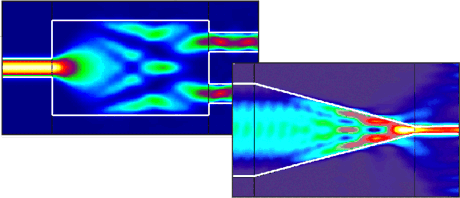FIMMPROPA bi-directional optical propagation tool |
   |
IntroductionWhat is FIMMPROP?FIMMPROP is a highly innovative tool for simulating propagation in optical waveguides in 2D and 3D, which is fully integrated as part of our optical mode solver FIMMWAVE and relies on the rigorous EigenMode Expansion (EME) method. A powerful and versatile optical propagation toolFIMMPROP is ideal for the modelling of optical propagation in structures with high refractive-index contrast, commonly found in silicon photonics and III-V integrated optics, for which approximate techniques such as the beam propagation method (BPM) would be inaccurate, and methods such as FDTD or FEM would be extremely slow. This includes the simulation and optimisation of devices such as MMI couplers, optical gratings, co-directional couplers or polarisation converters. Thanks to its unique adaptive taper algorithm, it is also a very accurate and efficient method for the modelling of optical tapers (e.g. mode-size converters) and slowly z-varying structures such as ring resonators and Y-junctions. For modelling optical gratings, FIMMPROP can use either EME or a form of RCMT (Rigorous Coupled Mode Theory) enhanced by Photon Design. The two methods are complementary, RCMT allowing you to model many grating geometries more efficiently and accurately than EME. It can also model propagation in optical fibers, allowing you to simulate many types of fiber to chip couplers, tapered fibers and lensed fibers as well as fiber Bragg gratings. FIMMPROP is an extremely versatile tool which can also model plasmonic waveguides, AR coatings for waveguide facets and photonic crystal fiber devices.
Explore the underlying physics of your designsFIMMPROP is a great tool for the thinking optics designer since it provides not only a simulation result, but also a deep insight into what is going on inside the device thanks to its eigenmode approach, providing you with invaluable hints on how to improve your structures. Where methods such FDTD or BPM which would only provide you with the transmission, you will be able to study the evolution of mode power and mode properties along the structure, and find out exactly where and why your taper is radiating! Benefits of EigenMode ExpansionFIMMPROP is based on the powerful EigenMode Expansion method (EME), with the following benefits:
Comparison of the EME, BPM and FDTD methods Component design your for PIC circuit modelComponents modelled with FIMMPROP can be easily exported to PICWave where they can be integrated in the simulation of photonic integrated circuits (PICs). Link to ray tracing toolsFIMMPROP can import beam profiles from FRED and Zemax, and can export optical profiles back into these ray tracing tools.
PlatformsPC min spec: Win 8/10 x64, 4GB RAM, Intel Haswell, AMD Ryzen2 or later CPU.
|




